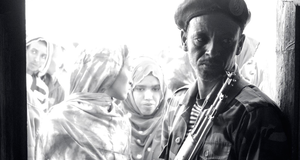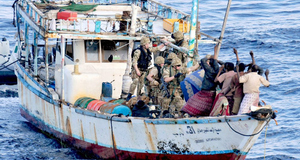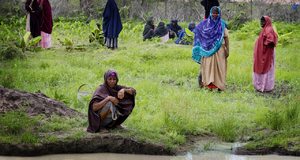From Interstate - Journal of International Affairs VOL. 1996/1997 NO. 2The Western Media and Africa: Issues of Information and ImagesThe Somali CrisisPrior to 1992, when the country received international attention, there had been famine. 350,000 human lives were taken by the drought.(4) It was only when Save the Children Fund and other humanitarian agencies took action that international attention on Somalia was increased. In 1992 a US military airlift of 145,000 tons of food to displaced Somalis in neighbouring Kenya brought the expected media coverage. Somalia’s profile was raised by this “Operation Provide Relief.” Why was there this turnaround in attention and action? Minear, Scott and Weiss put it down to three factors: Firstly, a herd instinct of the news media in which TV and newspaper crews compete with each other to get big scoops and stories for their employers. Secondly, in July 1992, the then Secretary-General of the UN, Boutros-Boutros Ghali, said that Somalia was the victim of a highly publicised “rich man’s war” in the former Yugoslavia. His comment stung Western governments into action. Thirdly, a small number of European and American- based humanitarian agencies used firsthand accounts of Somalia in a combined campaign to increase international attention to the crisis. Of all the media forms, television was the major stimulus in provoking Washington’s military intervention and Washington’s abrupt withdrawal. The then Secretary of State, Lawrence Eagleburger said “Television had a great deal to do with President Bush’s decision to go in.” Once committed to intervention, US policymakers sought and received endorsement from the media. The reversal of the American intervention emerged with the deterioration in the security situation, faltering humanitarian operations and the American retaliatory attack on Somalis as a result of the deaths of 23 Pakistani troops serving with the UN, on the 5th June 1993. American bombing raids on Mogadishu in 1993 killed more than a thousand Somalis and turned the UN and US into a hated presence. Then came the broadcasts of Somali video pictures of a dead US marine being dragged through the streets of Mogadishu in early October 1993. By the end of that month, 21 American soldiers had been killed and 75 wounded. These pictures led to a direct and swift US policy reversal. According to the Chairman of a Congressional Committee: “Pictures of the starving children, not policy objectives, got us into Somalia in 1992. Pictures of US casualties, not the completion of our objectives, led us to exit Somalia.”(5) There followed a White House announcement of a countdown to military withdrawal. Secretary of State Eagleburger had initially believed that America could intervene “without any great danger of body bags coming home.” How wrong he was! US troops withdrew on 25th March 1994. How did the Western media portray the Somali crisis? On television the predominant images were of starving people and gun-wielding soldiers. In the US, the American public were told that Somalis were stoned out of their minds everyday on the drug Khat, which is no stronger than coffee.(6) What were the real issues that were masked in the media’s representation of issues? Firstly, very few journalists analysed the conditions that had helped generate the conflict. Western journalists such as Mark Huband attempted to do so. Huband made the point that in some ways the West and Russia who supplied weapons to Somalia are responsible for sowing the seeds of destruction and that the fracturing of society would not have been possible were it not for the external weapons Siad Barre received during his 21 years in power.(7) Secondly, the predominant approach of the media was to portray the conflict in Somalia in complete isolation from the entire history of the Horn of Africa, whereby colonialism led to the direct carving up of the Somali people into different territories ruled by various European powers. Thirdly, in 1980, US Congressman Solarz advised the Carter administration to stay out of Somalia because it had neither strategic nor economic importance to the US.(8) Eleven years later, before the pro-US regime of Siad Barre was overthrown in 1991, his regime had signed oil development rights with the American oil giants Conoco, Amoco, Chevron and Philips. These companies were sitting on a mining fortune, yet this issue did not get one inch of coverage during the debacle. The Rwandan ConflictAccording to Minear, Scott and Weiss, before the genocide was unleashed in April 1994 in Rwanda, the signals of a possible crisis went largely unreported and unheeded by the news media, humanitarian agencies and governments. The slaughter of Batutsi and Bahutus took place amid total international indifference. According to Africa Confidential “the carnage began barely an hour after the shooting down of the presidential plane” that killed both the Rwandan and Burundian presidents on the 6th April 1994.(9) The main African story in the media at the time was the UN withdrawal from Somalia. The world’s attention was also focused on the inauguration of Nelson Mandela, at which there were roughly 500 foreign journalists, compared to the 6 or 7 journalists in Rwanda.(10) It was the refugee exodus of July 1994 and the subsequent cholera epidemic which received considerable media attention. By late 1994 media coverage had petered out. How did the Western media portray the Rwanda crisis? The relative absence of news people on the ground in Rwanda contributed to the general lack of understanding of the dynamics of the situation. Consequently, the conflict was immediately characterised as a tribal Hutu versus Tutsi orgy of killing. The portrayal of the conflict as n historical feud of latent primordial identities gave western governments a gladly received cover for inaction. What were the real issues and facts that were obscured by the Western reporting of the Rwandan crisis? The biggest obfuscation was the simplification of the crisis into an alleged spontaneous conflict between two distinct tribes – Hutu versus Tutsi. The Rwandan crisis is not an ancient tribal conflict, but an intensely modern conflict about wealth, land and political power in a weak post-colonial state that was supported by the former Belgian colonial power and later by the French. The media coverage masked the fundamental fact that the Bahutu and Batutsi and one people, known as the Banyarwanda. They are not separate and distinct tribes. Prior to Belgian colonialism the Batutsi, Bahutu and Twa subgroups practised a system known as Kwihutura, which allowed a Hutu to become a cattle owner ie a Tutsi and shed “Hutu-ness.” It also worked the other way, a Tutsi who lost his cattle could be demoted and join the ranks of the Hutu. This system therefore encouraged not only ethnic integration but intermarriage and social mobility. The coming of Belgian colonialism dismantled the Kwihtura system because the Belgians based their colonial administration on “divide and rule” tactics. The Tutsi became the colonial agents of the Belgians and were set against the Hutu. After 400 years of coexistence, the two groups had become polarised. The legacy of Belgian colonialism is the engineering of tribal and political differences which were to lay the seeds for the politicisation of ethnicity, which then led to the genocide and bloodletting. ConclusionIn the two case studies, I have tried to show how Western governments are heavily influenced by where television crews decide to place themselves. The media has acquired a powerful influence on Western public opinion which has then pushed governments and humanitarian agencies to act on international issues. Undoubtedly, the Western media’s portrayal of Africa is influenced by certain criterion which severely constrain its selection of foreign news stories. These criterion are as Bosah Ebo outlines, commercial interests, socio-cultural bias and political concerns. In a field and profession that has been based on the old tradition of “detached neutral reporting,” this old journalistic orthodoxy has become nothing more than a smokescreen for disguising and simplifying the role Western governments and companies have played in the exploitation of African countries. One of the many important roles of the press in any society is to communicate with its readers the way it understands and interprets the world. However, if that interpretation of the world is fundamentally flawed, then the media cannot hold a mirror up to the world, be independent, nor be the guardian of truth. The picture of Africa that emerges in the Western media is often vastly different from the reality. Yet there are very good reasons for concealing reality, since the maintenance of the existing domestic and international power structures are at stake. Endnotes
Suggested Reading from Inquiries Journal
Inquiries Journal provides undergraduate and graduate students around the world a platform for the wide dissemination of academic work over a range of core disciplines. Representing the work of students from hundreds of institutions around the globe, Inquiries Journal's large database of academic articles is completely free. Learn more | Blog | Submit Latest in International Affairs |

















